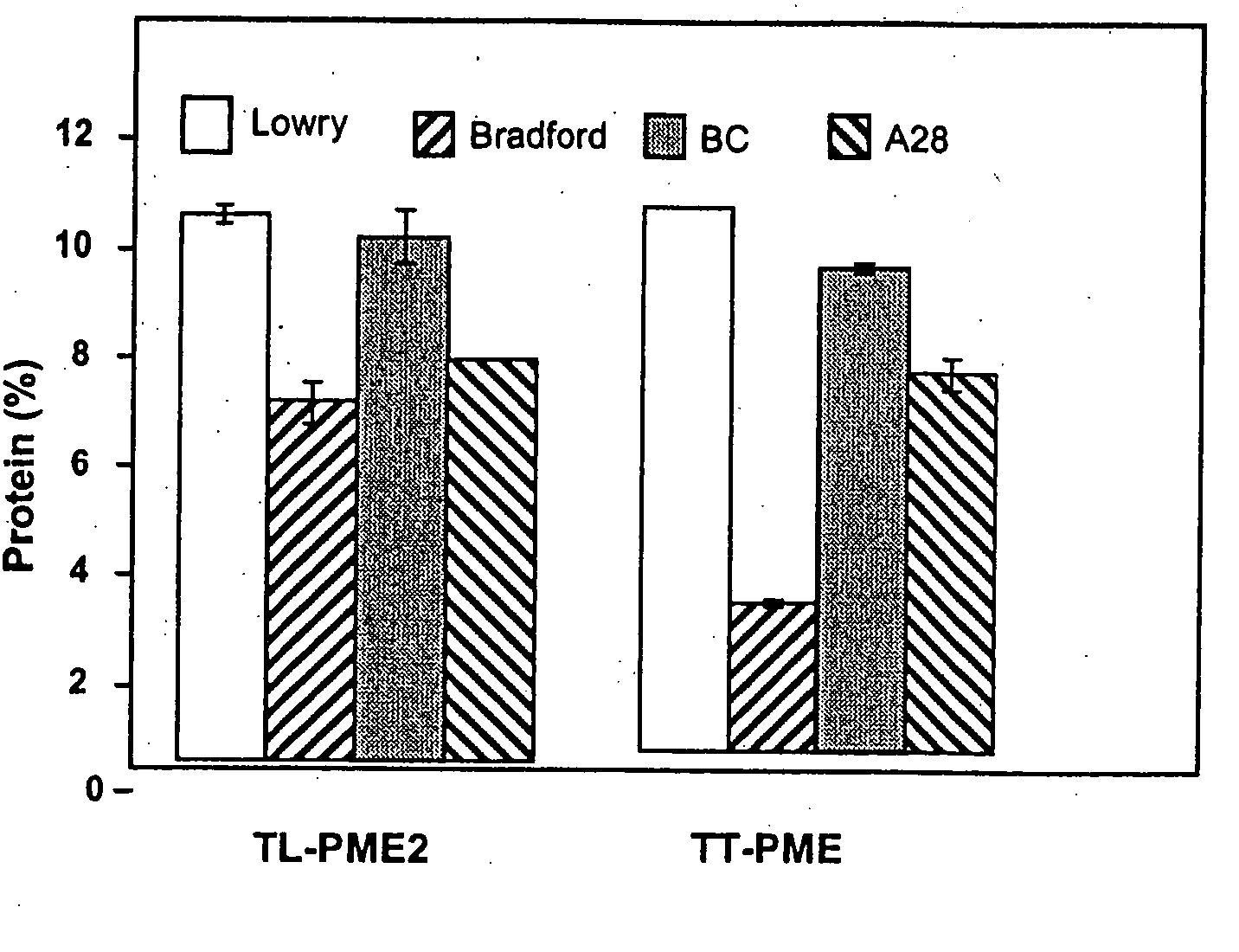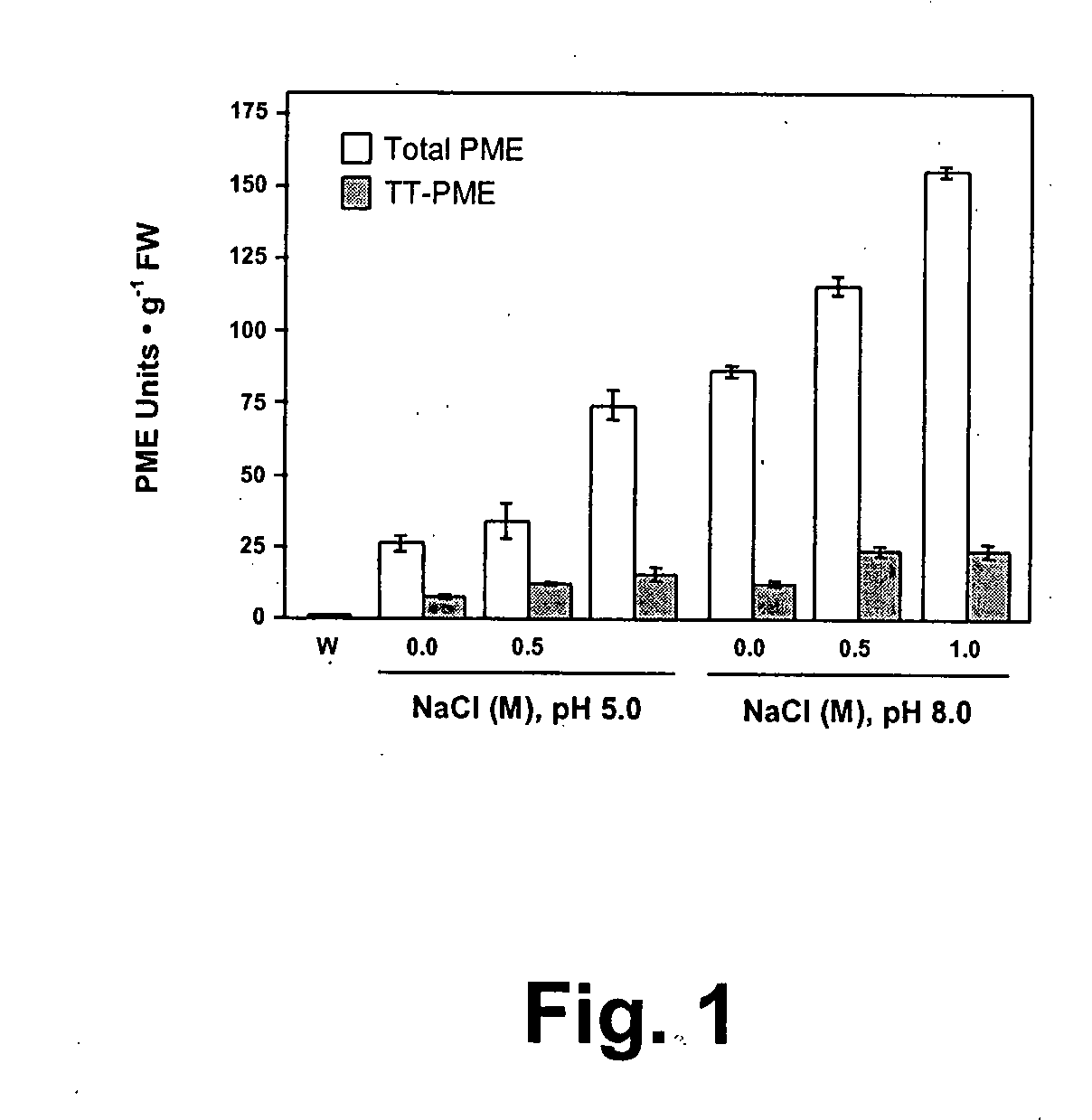Thermally-tolerant pectin methylesterase
a technology of pectin methylesterase and polypeptide, which is applied in the direction of transferases, organic chemistry, enzymology, etc., can solve the problems of affecting the reconstitution process, affecting the largely flavorless clear serum, so as to improve the processing or appearance of plant material, the effect of reducing the viscosity
- Summary
- Abstract
- Description
- Claims
- Application Information
AI Technical Summary
Benefits of technology
Problems solved by technology
Method used
Image
Examples
example 1
Methods Utilized for Analysis of Protein Preparations
[0084]Protein Determination Assay. Protein concentrations were determined according to the method of Lowry et al. (1951. J. Biol. Chem. 193: 265-275) using bovine serum albumin as standard. Coomassie blue reagent (Biorad Laboratories, Hercules, Calif.) and the bicinchonic acid reagents (Pierce Chemical Co., Rockford, Ill.) were used to compare determination for purified PME. All determinations were performed according to the standard protocol supplied by the manufacturer. Protein content of purified PME was also determined by absorbance at 280 nm using the extinction co-efficient calculated from the protein composition of the mature protein using the ProtParam program at the ExPASy proteomics tool website (http: / / au.expasy.org / tools / ).
[0085]Enzyme Activity Assay. PME activity was determined by pH-stat titration as previously described (Savary et al. 2002, supra) using a TIM 854 autotitrator (Radiometer Analytical, Loveland, Colo.)...
example 2
PME Extraction Trials
[0093]Sweet orange finisher pulp (Citrus sinensis cv. Hamlin or Valencia) was obtained from Citrus World (Lake Wells, Fla.) and stored frozen at −20° C. prior to use. Aliquots of approximately 10 g of finisher pulp were extracted with different buffers (1:3, w / v) and sodium chloride concentrations to determine effective conditions for scaled-up TT-PME isolation. All chemicals and solvents were of analytical grade and purchased from Sigma-Aldrich Chemical Company (St. Louis, Mo.), unless otherwise specified. Extractants used were either water without adjustment to endogenous pH of pulp slurry (pH 3.6) or buffered solutions containing either 0.1 M Tris-HCl, pH 8.0 or 0.02 M sodium acetate, pH 5.0, containing varying sodium chloride content (0.0, 0.1, 0.5 or 1.0 M). Since no soluble PME activity was detected in salt-free water extracts, the finisher pulp was washed with water until a clear-running solution was obtained, and then this treated pulp was used for extra...
example 3
Preparative Purification of TT-PME
[0096]A full-scale preparative purification of TT-PME from finisher pulp was processed (FIG. 4) combining ultrafiltration, heat treatment, differential adsorption of pectinates by anion -exchange chromatography, and selective affinity-binding to immobilized PME-IP. Preparative extraction of washed finisher pulp (1.3 kg) for TT-PME purification was performed with 0.02 M acetate buffer containing 0.5 M sodium chloride. Thawed finisher pulp was washed 5 times (2 hrs each treatment) with 4.5 L water containing 0.05 M sodium chloride (resulting in a clear-running final filtrate). The washed pulp was extracted overnight at 4° C. with continuous stirring using 4.5 L of 0.02 M sodium acetate containing 0.5 M sodium chloride and 0.02% sodium azide, and adjusting to pH 5. with sodium hydroxide. The extract was filtered through two layers of Miracloth (Calbiochem) and clarified by centrifugation at 8000 rpm (Sorvall SLC-6000 rotor) for 40 min (4° C). Suspended...
PUM
| Property | Measurement | Unit |
|---|---|---|
| temperature | aaaaa | aaaaa |
| pH | aaaaa | aaaaa |
| temperature | aaaaa | aaaaa |
Abstract
Description
Claims
Application Information
 Login to View More
Login to View More - R&D
- Intellectual Property
- Life Sciences
- Materials
- Tech Scout
- Unparalleled Data Quality
- Higher Quality Content
- 60% Fewer Hallucinations
Browse by: Latest US Patents, China's latest patents, Technical Efficacy Thesaurus, Application Domain, Technology Topic, Popular Technical Reports.
© 2025 PatSnap. All rights reserved.Legal|Privacy policy|Modern Slavery Act Transparency Statement|Sitemap|About US| Contact US: help@patsnap.com



